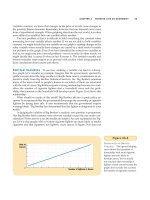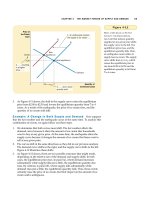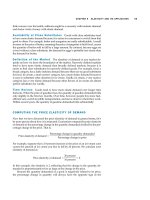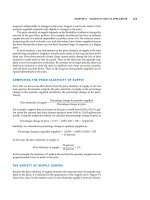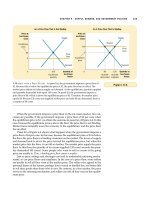Tài liệu Ten Principles of Economics - Part 33 pdf
Bạn đang xem bản rút gọn của tài liệu. Xem và tải ngay bản đầy đủ của tài liệu tại đây (268.16 KB, 10 trang )
CHAPTER 15 MONOPOLY 331
◆ By turning some private monopolies into public enterprises
◆ By doing nothing at all
INCREASING COMPETITION WITH ANTITRUST LAWS
If Coca-Cola and Pepsico wanted to merge, the deal would be closely examined by
the federal government before it went into effect. The lawyers and economists in
the Department of Justice might well decide that a merger between these two large
soft drink companies would make the U.S. soft drink market substantially less
competitive and, as a result, would reduce the economic well-being of the country
as a whole. If so, the Justice Department would challenge the merger in court, and
if the judge agreed, the two companies would not be allowed to merge. It is pre-
cisely this kind of challenge that prevented software giant Microsoft from buying
Intuit in 1994.
The government derives this power over private industry from the antitrust
laws, a collection of statutes aimed at curbing monopoly power. The first and most
important of these laws was the Sherman Antitrust Act, which Congress passed in
1890 to reduce the market power of the large and powerful “trusts” that were
viewed as dominating the economy at the time. The Clayton Act, passed in 1914,
strengthened the government’s powers and authorized private lawsuits. As the
U.S. Supreme Court once put it, the antitrust laws are “a comprehensive charter of
economic liberty aimed at preserving free and unfettered competition as the rule
of trade.”
“But if we do merge with Amalgamated, we’ll have enough resources to fight the
anti-trust violation caused by the merger.”
332 PART FIVE FIRM BEHAVIOR AND THE ORGANIZATION OF INDUSTRY
The antitrust laws give the government various ways to promote competition.
They allow the government to prevent mergers, such as our hypothetical merger
between Coca-Cola and Pepsico. They also allow the government to break up com-
panies. For example, in 1984 the government split up AT&T, the large telecommu-
nications company, into eight smaller companies. Finally, the antitrust laws prevent
companies from coordinating their activities in ways that make markets less com-
petitive; we will discuss some of these uses of the antitrust laws in Chapter 16.
Antitrust laws have costs as well as benefits. Sometimes companies merge not
to reduce competition but to lower costs through more efficient joint production.
These benefits from mergers are sometimes called synergies. For example, many
U.S. banks have merged in recent years and, by combining operations, have been
able to reduce administrative staff. If antitrust laws are to raise social welfare, the
government must be able to determine which mergers are desirable and which are
not. That is, it must be able to measure and compare the social benefit from syner-
gies to the social costs of reduced competition. Critics of the antitrust laws are
skeptical that the government can perform the necessary cost-benefit analysis with
sufficient accuracy.
REGULATION
Another way in which the government deals with the problem of monopoly is by
regulating the behavior of monopolists. This solution is common in the case of nat-
ural monopolies, such as water and electric companies. These companies are not
allowed to charge any price they want. Instead, government agencies regulate
their prices.
What price should the government set for a natural monopoly? This question
is not as easy as it might at first appear. One might conclude that the price should
equal the monopolist’s marginal cost. If price equals marginal cost, customers will
buy the quantity of the monopolist’s output that maximizes total surplus, and the
allocation of resources will be efficient.
There are, however, two practical problems with marginal-cost pricing as a
regulatory system. The first is illustrated in Figure 15-9. Natural monopolies, by
definition, have declining average total cost. As we discussed in Chapter 13, when
average total cost is declining, marginal cost is less than average total cost. If regu-
lators are to set price equal to marginal cost, that price will be less than the firm’s
average total cost, and the firm will lose money. Instead of charging such a low
price, the monopoly firm would just exit the industry.
Regulators can respond to this problem in various ways, none of which is per-
fect. One way is to subsidize the monopolist. In essence, the government picks up
the losses inherent in marginal-cost pricing. Yet to pay for the subsidy, the govern-
ment needs to raise money through taxation, which involves its own deadweight
losses. Alternatively, the regulators can allow the monopolist to charge a price
higher than marginal cost. If the regulated price equals average total cost, the mo-
nopolist earns exactly zero economic profit. Yet average-cost pricing leads to dead-
weight losses, because the monopolist’s price no longer reflects the marginal cost
of producing the good. In essence, average-cost pricing is like a tax on the good the
monopolist is selling.
The second problem with marginal-cost pricing as a regulatory system (and
with average-cost pricing as well) is that it gives the monopolist no incentive to
CHAPTER 15 MONOPOLY 333
reduce costs. Each firm in a competitive market tries to reduce its costs because
lower costs mean higher profits. But if a regulated monopolist knows that regula-
tors will reduce prices whenever costs fall, the monopolist will not benefit from
lower costs. In practice, regulators deal with this problem by allowing monopolists
to keep some of the benefits from lower costs in the form of higher profit, a prac-
tice that requires some departure from marginal-cost pricing.
PUBLIC OWNERSHIP
The third policy used by the government to deal with monopoly is public owner-
ship. That is, rather than regulating a natural monopoly that is run by a private
firm, the government can run the monopoly itself. This solution is common in
many European countries, where the government owns and operates utilities such
as the telephone, water, and electric companies. In the United States, the govern-
ment runs the Postal Service. The delivery of ordinary First Class mail is often
thought to be a natural monopoly.
Economists usually prefer private to public ownership of natural monopolies.
The key issue is how the ownership of the firm affects the costs of production. Pri-
vate owners have an incentive to minimize costs as long as they reap part of the
benefit in the form of higher profit. If the firm’s managers are doing a bad job of
keeping costs down, the firm’s owners will fire them. By contrast, if the govern-
ment bureaucrats who run a monopoly do a bad job, the losers are the customers
and taxpayers, whose only recourse is the political system. The bureaucrats may
become a special-interest group and attempt to block cost-reducing reforms. Put
simply, as a way of ensuring that firms are well run, the voting booth is less reli-
able than the profit motive.
Average total
cost
Regulated
price
Quantity0
Loss
Price
Demand
Marginal cost
Average total cost
Figure 15-9
MARGINAL-COST PRICING FOR A
NATURAL MONOPOLY. Because
a natural monopoly has declining
average total cost, marginal cost
is less than average total cost.
Therefore, if regulators require a
natural monopoly to charge a
price equal to marginal cost,
price will be below average
total cost, and the monopoly
will lose money.
334 PART FIVE FIRM BEHAVIOR AND THE ORGANIZATION OF INDUSTRY
DOING NOTHING
Each of the foregoing policies aimed at reducing the problem of monopoly has
drawbacks. As a result, some economists argue that it is often best for the govern-
ment not to try to remedy the inefficiencies of monopoly pricing. Here is the as-
sessment of economist George Stigler, who won the Nobel Prize for his work in
industrial organization, writing in the Fortune Encyclopedia of Economics:
A famous theorem in economics states that a competitive enterprise economy
will produce the largest possible income from a given stock of resources. No real
economy meets the exact conditions of the theorem, and all real economies will
IN MANY CITIES
, THE MASS TRANSIT SYSTEM
of buses and subways is a monopoly
run by the local government. But is this
the best system?
Man with a Van
B
Y JOHN
TIERNEY
Vincent Cummins looks out from his van
with the wary eyes of a hardened crimi-
nal. It is quiet this evening in downtown
Brooklyn . . . too quiet. “Watch my back
for me!” he barks into the microphone of
his C.B. radio, addressing a fellow out-
law in a van who just drove by him on
Livingston Street. He looks left and right.
No police cars in sight. None of the
usual unmarked cars, either. Cummins
pauses for a second—he has heard on
the C.B. that cops have just busted two
other drivers—but he can’t stop himself.
“Watch my back!” he repeats into the
radio as he ruthlessly pulls over to the
curb.
Five seconds later, evil triumphs.
A
middle-aged woman with a shopping bag
climbs into the van . . . and Cummins dri-
ves off with impunity!
His new victim and
the other passengers laugh when asked
why they’re riding this illegal jitney. What
fool would pay $1.50 to stand on the bus
or subway when you’re guaranteed a
seat here for $1? Unlike bus drivers, the
van drivers make change and accept
bills, and the vans run more frequently at
every hour of the day. “It takes me an
hour to get home if I use the bus,” ex-
plains Cynthia Peters, a nurse born in
Trinidad. “When I’m working late, it’s
very scary waiting in the dark for the bus
and then walking the three blocks home.
With Vincent’s van, I get home in less
than half an hour. He takes me right to
the door and waits until I get inside.”
Cummins would prefer not to be an
outlaw. A native of Barbados, he has
been driving his van full time ever since
an injury forced him to give up his job as
a machinist. “I could be collecting dis-
ability,” he says, “but it’s better to
work.” He met Federal requirements to
run an interstate van service, then spent
years trying to get approval to operate in
the city. His application, which included
more than 900 supporting statements
from riders, business groups, and church
leaders, was approved by the City Taxi
and Limousine Commission as well as
by the Department of Transportation.
Mayor Giuliani supported him. But this
summer the City Council rejected his ap-
plication for a license, as it has rejected
most applications over the past four
years, which is why thousands of illegal
drivers in Brooklyn and Queens are
dodging the police.
IN THE NEWS
Public Transport and
Private Enterprise
VINCENT CUMMINS: OUTLAW ENTREPRENEUR
CHAPTER 15 MONOPOLY 335
fall short of the ideal economy—a difference called “market failure.” In my view,
however, the degree of “market failure” for the American economy is much
smaller than the “political failure” arising from the imperfections of economic
policies found in real political systems.
As this quotation makes clear, determining the proper role of the government in
the economy requires judgments about politics as well as economics.
QUICK QUIZ: Describe the ways policymakers can respond to the
inefficiencies caused by monopolies. List a potential problem with each of
these policy responses.
Council members claim they’re try-
ing to prevent vans from causing acci-
dents and traffic problems, although no
one who rides the vans takes these
protestations seriously. Vans with accred-
ited and insured drivers like Cummins are
no more dangerous or disruptive than
taxis. The only danger they pose is to the
public transit monopoly, whose union
leaders have successfully led the cam-
paign against them.
The van drivers have refuted two
modern urban myths: that mass transit
must lose money and that it must be a
public enterprise. Entrepreneurs like
Cummins are thriving today in other
cities—Seoul and Buenos Aires rely en-
tirely on private, profitable bus compa-
nies—and they once made New York the
world leader in mass transit. The first
horsecars and elevated trains were de-
veloped here by private companies. The
first subway was partly financed with a
loan from the city, but it was otherwise a
private operation, built and run quite
profitably with the fare set at a nickel—
the equivalent of less than a dollar today.
Eventually though, New York’s politi-
cians drove most private transit compa-
nies out of business by refusing to adjust
the fare for inflation. When the enter-
prises lost money in the 1920’s, Mayor
John Hylan offered to teach them efficient
management. If the city ran the subway,
he promised, it would make money while
preserving the nickel fare and freeing
New Yorkers from “serfdom” and “dicta-
torship” of the “grasping transportation
monopolies.” But expenses soared as
soon as government merged the private
systems into a true monopoly. The fare,
which remained a nickel through seven
decades of private transit, has risen 2,900
percent under public management—and
today the Metropolitan Transportation Au-
thority still manages to lose about $2 per
ride. Meanwhile, a jitney driver can pro-
vide better service at lower prices and still
make a profit.
“Transit could be profitable again if
entrepreneurs are given a chance,” says
Daniel B. Klein, an economist at Santa
Clara University in California and the co-
author of
Curb Rights,
a new book from
the Brookings Institution on mass transit.
“Government has demonstrated that it
has no more business producing transit
than producing cornflakes. It should con-
centrate instead on establishing new
rules to foster competition.” To encour-
age private operators to make a long-
term investment in regular service along
a route, the Brookings researchers rec-
ommend selling them exclusive “curb
rights” to pick up passengers waiting at
certain stops along the route. That way
part-time opportunists couldn’t swoop in
to steal regular customers from a long-
term operator. But to encourage compe-
tition, at other corners along the route
there should also be common stops
where passengers could be picked up by
any licensed jitney or bus.
Elements of this system already ex-
ist where jitneys have informally estab-
lished their own stops separate from the
regular buses, but the City Council is try-
ing to eliminate these competitors. Be-
sides denying licenses to new drivers
like Cummins, the Council has forbidden
veteran drivers with licenses to operate
on bus routes. Unless these restrictions
are overturned in court—a suit on the
drivers’ behalf has been filed by the Insti-
tute for Justice, a public-interest law firm
in Washington—the vans can compete
only by breaking the law. At this very mo-
ment, despite the best efforts of the po-
lice and the Transport Workers Union,
somewhere in New York a serial preda-
tor like Cummins is luring another unsus-
pecting victim. He may even be making
change for a $5 bill.
S
OURCE: The New York Times Magazine, August 10,
1997, p. 22.
336 PART FIVE FIRM BEHAVIOR AND THE ORGANIZATION OF INDUSTRY
PRICE DISCRIMINATION
So far we have been assuming that the monopoly firm charges the same price to all
customers. Yet in many cases firms try to sell the same good to different customers
for different prices, even though the costs of producing for the two customers are
the same. This practice is called price discrimination.
Before discussing the behavior of a price-discriminating monopolist, we
should note that price discrimination is not possible when a good is sold in a com-
petitive market. In a competitive market, there are many firms selling the same
good at the market price. No firm is willing to charge a lower price to any cus-
tomer because the firm can sell all it wants at the market price. And if any firm
tried to charge a higher price to a customer, that customer would buy from another
firm. For a firm to price discriminate, it must have some market power.
A PARABLE ABOUT PRICING
To understand why a monopolist would want to price discriminate, let’s consider
a simple example. Imagine that you are the president of Readalot Publishing Com-
pany. Readalot’s best-selling author has just written her latest novel. To keep
things simple, let’s imagine that you pay the author a flat $2 million for the exclu-
sive rights to publish the book. Let’s also assume that the cost of printing the book
is zero. Readalot’s profit, therefore, is the revenue it gets from selling the book mi-
nus the $2 million it has paid to the author. Given these assumptions, how would
you, as Readalot’s president, decide what price to charge for the book?
Your first step in setting the price is to estimate what the demand for the book
is likely to be. Readalot’s marketing department tells you that the book will attract
two types of readers. The book will appeal to the author’s 100,000 die-hard fans.
These fans will be willing to pay as much as $30 for the book. In addition, the book
will appeal to about 400,000 less enthusiastic readers who will be willing to pay up
to $5 for the book.
What price maximizes Readalot’s profit? There are two natural prices to con-
sider: $30 is the highest price Readalot can charge and still get the 100,000 die-hard
fans, and $5 is the highest price it can charge and still get the entire market of
500,000 potential readers. It is a matter of simple arithmetic to solve Readalot’s
problem. At a price of $30, Readalot sells 100,000 copies, has revenue of $3 million,
and makes profit of $1 million. At a price of $5, it sells 500,000 copies, has revenue
of $2.5 million, and makes profit of $500,000. Thus, Readalot maximizes profit by
charging $30 and forgoing the opportunity to sell to the 400,000 less enthusiastic
readers.
Notice that Readalot’s decision causes a deadweight loss. There are 400,000
readers willing to pay $5 for the book, and the marginal cost of providing it to
them is zero. Thus, $2 million of total surplus is lost when Readalot charges the
higher price. This deadweight loss is the usual inefficiency that arises whenever a
monopolist charges a price above marginal cost.
Now suppose that Readalot’s marketing department makes an important dis-
covery: These two groups of readers are in separate markets. All the die-hard fans
live in Australia, and all the other readers live in the United States. Moreover, it is
price discrimination
the business practice of selling the
same good at different prices to
different customers
CHAPTER 15 MONOPOLY 337
difficult for readers in one country to buy books in the other. How does this dis-
covery affect Readalot’s marketing strategy?
In this case, the company can make even more profit. To the 100,000 Australian
readers, it can charge $30 for the book. To the 400,000 American readers, it can
charge $5 for the book. In this case, revenue is $3 million in Australia and $2 mil-
lion in the United States, for a total of $5 million. Profit is then $3 million, which is
substantially greater than the $1 million the company could earn charging the
same $30 price to all customers. Not surprisingly, Readalot chooses to follow this
strategy of price discrimination.
Although the story of Readalot Publishing is hypothetical, it describes accu-
rately the business practice of many publishing companies. Textbooks, for example,
are often sold at a lower price in Europe than in the United States. Even more im-
portant is the price differential between hardcover books and paperbacks. When a
publisher has a new novel, it initially releases an expensive hardcover edition and
later releases a cheaper paperback edition. The difference in price between these two
editions far exceeds the difference in printing costs. The publisher’s goal is just as in
our example. By selling the hardcover to die-hard fans and the paperback to less en-
thusiastic readers, the publisher price discriminates and raises its profit.
THE MORAL OF THE STORY
Like any parable, the story of Readalot Publishing is stylized. Yet, also like any
parable, it teaches some important and general lessons. In this case, there are three
lessons to be learned about price discrimination.
The first and most obvious lesson is that price discrimination is a rational
strategy for a profit-maximizing monopolist. In other words, by charging different
prices to different customers, a monopolist can increase its profit. In essence, a
price-discriminating monopolist charges each customer a price closer to his or her
willingness to pay than is possible with a single price.
The second lesson is that price discrimination requires the ability to separate
customers according to their willingness to pay. In our example, customers were
separated geographically. But sometimes monopolists choose other differences,
such as age or income, to distinguish among customers.
A corollary to this second lesson is that certain market forces can prevent firms
from price discriminating. In particular, one such force is arbitrage, the process of
buying a good in one market at a low price and selling it in another market at a
higher price in order to profit from the price difference. In our example, suppose
that Australian bookstores could buy the book in the United States and resell it to
Australian readers. This arbitrage would prevent Readalot from price discriminat-
ing because no Australian would buy the book at the higher price.
The third lesson from our parable is perhaps the most surprising: Price dis-
crimination can raise economic welfare. Recall that a deadweight loss arises when
Readalot charges a single $30 price, because the 400,000 less enthusiastic readers
do not end up with the book, even though they value it at more than its marginal
cost of production. By contrast, when Readalot price discriminates, all readers end
up with the book, and the outcome is efficient. Thus, price discrimination can elim-
inate the inefficiency inherent in monopoly pricing.
Note that the increase in welfare from price discrimination shows up as higher
producer surplus rather than higher consumer surplus. In our example, consumers
338 PART FIVE FIRM BEHAVIOR AND THE ORGANIZATION OF INDUSTRY
are no better off for having bought the book: The price they pay exactly equals the
value they place on the book, so they receive no consumer surplus. The entire in-
crease in total surplus from price discrimination accrues to Readalot Publishing in
the form of higher profit.
THE ANALYTICS OF PRICE DISCRIMINATION
Let’s consider a bit more formally how price discrimination affects economic wel-
fare. We begin by assuming that the monopolist can price discriminate perfectly.
Perfect price discrimination describes a situation in which the monopolist knows ex-
actly the willingness to pay of each customer and can charge each customer a dif-
ferent price. In this case, the monopolist charges each customer exactly his
willingness to pay, and the monopolist gets the entire surplus in every transaction.
Figure 15-10 shows producer and consumer surplus with and without price
discrimination. Without price discrimination, the firm charges a single price above
marginal cost, as shown in panel (a). Because some potential customers who value
the good at more than marginal cost do not buy it at this high price, the monopoly
causes a deadweight loss. Yet when a firm can perfectly price discriminate, as
shown in panel (b), each customer who values the good at more than marginal cost
buys the good and is charged his willingness to pay. All mutually beneficial trades
take place, there is no deadweight loss, and the entire surplus derived from the
market goes to the monopoly producer in the form of profit.
(a) Monopolist with Single Price
Price
0
QuantityQuantity sold Quantity sold
(b) Monopolist with Perfect Price Discrimination
Price
0 Quantity
Monopoly
price
Profit
Profit
Deadweight
loss
Demand Demand
Marginal cost
Marginal
revenue
Consumer
surplus
Marginal cost
Figure 15-10
WELFARE WITH AND WITHOUT PRICE DISCRIMINATION. Panel (a) shows a monopolist
that charges the same price to all customers. Total surplus in this market equals the sum of
profit (producer surplus) and consumer surplus. Panel (b) shows a monopolist that can
perfectly price discriminate. Because consumer surplus equals zero, total surplus now
equals the firm’s profit. Comparing these two panels, you can see that perfect price
discrimination raises profit, raises total surplus, and lowers consumer surplus.
CHAPTER 15 MONOPOLY 339
In reality, of course, price discrimination is not perfect. Customers do not walk
into stores with signs displaying their willingness to pay. Instead, firms price dis-
criminate by dividing customers into groups: young versus old, weekday versus
weekend shoppers, Americans versus Australians, and so on. Unlike those in our
parable of Readalot Publishing, customers within each group differ in their will-
ingness to pay for the product, making perfect price discrimination impossible.
How does this imperfect price discrimination affect welfare? The analysis of
these pricing schemes is quite complicated, and it turns out that there is no general
answer to this question. Compared to the monopoly outcome with a single price,
imperfect price discrimination can raise, lower, or leave unchanged total surplus
in a market. The only certain conclusion is that price discrimination raises the mo-
nopoly’s profit—otherwise the firm would choose to charge all customers the
same price.
EXAMPLES OF PRICE DISCRIMINATION
Firms in our economy use various business strategies aimed at charging different
prices to different customers. Now that we understand the economics of price dis-
crimination, let’s consider some examples.
Movie Tickets Many movie theaters charge a lower price for children and
senior citizens than for other patrons. This fact is hard to explain in a competitive
market. In a competitive market, price equals marginal cost, and the marginal cost
of providing a seat for a child or senior citizen is the same as the marginal cost of
providing a seat for anyone else. Yet this fact is easily explained if movie theaters
have some local monopoly power and if children and senior citizens have a lower
“Would it bother you to hear how little I paid for this flight?”
340 PART FIVE FIRM BEHAVIOR AND THE ORGANIZATION OF INDUSTRY
WHAT ORGANIZATION IN OUR ECONOMY IS
most successful at exerting market
power and keeping prices away from
their competitive levels? Economist
Robert Barro reports on the first (and
only) annual competition to find the
most successful monopoly.
Let’s Play Monopoly
BY ROBERT J. BARRO
It’s almost the end of summer and time
for the first annual contest to choose the
best operating monopoly in America. The
contestants, selected by a panel of Har-
vard economists, are as follows:
1. The U.S. Postal Service
2. OPEC [Organization of Petroleum
Exporting Countries]
3. Almost any cable TV company
4. The Ivy League universities (for
administering financial aid to
students)
5. The NCAA [National Collegiate
Athletic Association] (for
administering payments to student-
athletes) . . .
Each contestant exhibits fine monopolis-
tic characteristics and is worthy of seri-
ous consideration for the award. The
U.S. Postal Service claims to be the
longest-running monopoly in America
and has the distinction of having its con-
trol over First Class mail prescribed (per-
haps) by the Constitution. The monopoly
has preserved large flows of revenues
and high wage rates despite studies
showing that private companies could
carry the mail more efficiently at much
lower cost.
On the other hand, the position of
the Postal Service has been eroded:
first, by successful competition on pack-
age delivery; second, by the recent entry
of express delivery services; and third,
and potentially most damaging, by the in-
troduction of the fax machine. Since
faxes are bound to supplant a substantial
fraction of First Class letters, the failure
to get Congress to classify a fax as First
Class mail and, hence, the exclusive do-
main of the post office shows a remark-
able loss of political muscle. Thus,
despite past glories, it is hard to be san-
guine about the long-term prospects of
the post office as a flourishing monopoly.
OPEC was impressive in generating
billions of dollars for its members from
1973 to the early 1980s. To understand
the functioning of this cartel it is impor-
tant to sort out the good guys from the
bad guys.
The good guys, like Saudi Arabia and
Kuwait, are the ones who have typically
held oil production below capacity and
thereby kept prices above the competitive
level. The bad guys, like Libya and Iraq
(when Iraq was allowed to produce oil),
are the ones who have produced as much
as they could and thereby kept prices low.
The good guys were responsible for
the vast expansion of oil revenues during
the blissful period after 1973. (Hence,
they were responsible for the consider-
able difficulties endured by oil con-
sumers.) But, unfortunately, these
countries could not keep the other
OPEC members in line and were also un-
able to exclude new producers or pre-
vent conservation by consumers. Thus,
oil prices plummeted in 1986. . . .
In any event, it is unclear that
OPEC qualifies for the contest: It is not
really American, and its members would
IN THE NEWS
The Best Monopolist
IS THE
NCAA THE BEST MONOPOLIST?
